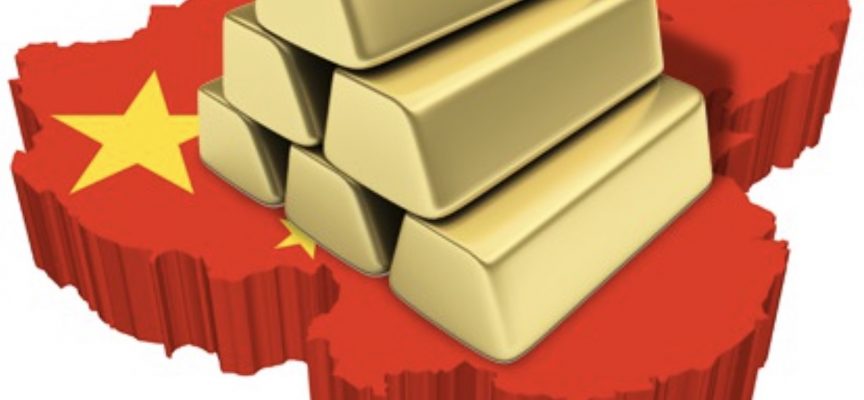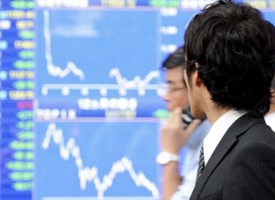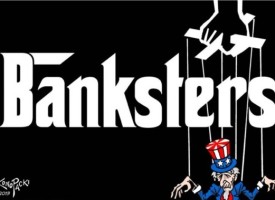As we approach the end of the third week of trading in April, in what has been a choppy environment in the gold and silver markets, a legend in the business that is connected in China at the highest levels just predicted a massive short squeeze in the gold market.
Price Of Gold To Surge More Than 70%!
By John Ing, Maison Placements
April 21 (King World News) – Since the 2008 recession, US households have lost nearly $13 trillion. Nine years after the financial crisis, the Trump reflation rally is up nearly 10 percent and since his election, U.S. household net worth has climbed an astonishing $93 trillion, on subsidized credit and hopes that Trump will bring back prosperity through growth. That ascent also reflects the overvaluation of real estate and the stock market leading to the highest consumer confidence since the peak of the dot.com bubble. And although, the Federal Reserve increased rates a quarter point, only the third time in 50 years, there are numerous credit distress stories from interest-sensitive car loans to shopping centers and of course retail spending…
IMPORTANT:
To find out which high-grade silver mining company billionaire Eric Sprott just purchased
a nearly 20% stake in and learn why he believes this is one of the most
exciting silver stories in the world – CLICK HERE OR BELOW:
While Candidate Trump’s promises to boost economic output through tax cuts, raising tariffs and infrastructure spending were successful enough to get him elected by the so-called forgotten American, President Trump’s failure to replace Obamacare has cast a cloud over his entire White House program. Now his tax reform plan faces even larger hurdles, sending a wave of risk aversion throughout global markets. The threats are both external and internal. The gap between campaign rhetoric and reliability is vast. The fault lines run deep. The judiciary also took a hit as the Republicans exercised the “nuclear option” to appoint Gorsuch to the Supreme Court, breaking 200 plus years of Senate tradition. Mr. Trump is hobbled by his rhetoric and his fractious party, many of who owe their seat to voters rather than Trump’s coattails, are exercising independence. That other branch of government, Congress found its voice having an important say in Mr. Trump’s vision and so everywhere, existing trends are being called into question. What will happen when the debt ceiling comes next, since he will need Democrats to avert a government shutdown by the end of April?
That debt ceiling was restored on March 16, 2017. Since 1960, Congress has raised the debt ceiling around 80 times and now Congress must raise it again. For now, the prospect of deficit spending, anathema to much of the Republican party is about to be tested when lifting the debt ceiling will raise the specter of gridlock on Capital Hill, ironically led by Trump’s own party in an ideological struggle over the vision of Trump and the legislative branch.
Mother of all Bubbles
Then in the aftermath, the Fed is considering the exit from a super-loose monetary stance and shrinking its crisis-era $4.5 trillion balance sheet laden with three rounds of quantitative easing and a debt load that is the mother of all bubbles. To avoid the inevitable pick-up in inflation, the Fed forced the banking system to boost their capital reserves as a means to increase capital ratios but also to sterilize those newly minted funds. Normalization will involve selling or allowing the trillions of Treasuries and mortgages to mature which could lead to higher rates. Noteworthy is that America could pay almost $1 trillion in interest payments on its whopping $20 trillion national debt, now at 100 percent of GDP but when unfunded entitlements are included, it is equal to 300 percent of GDP. Although, Mr. Obama doubled the national debt in only eight years, Trump’s ever higher America First spending and tax reform is a debt time bomb ready to explode.
Blame Game
While the Trump administration focuses on middle-class tax cuts, infrastructure spending and deregulation, few focus on the expansion of his massive budgetary deficit. The traditional media continues to harp about Trump the man, such that their role has become much more politicized. In fact, America’s institutions have similarly become politicized with a Fed government official admitting leaking information to the media or an Obama national security director coopting the Presidential race, blurring the roles between national interests and partisan politics – this is the swamp that requires draining.
Of concern is that abnormally low rates are at an end and as they become normalized, the trillions created so altered the capital markets, that they have become permanently mismatched, over leveraged and more vulnerable than in 2007-2008. Margin debt, for example, has climbed to a record in February and the price earnings ratio is higher than in 1999. Still complacency and blaseness exists and while the bond vigilantes of the past go missing, our euphoric markets will be caught off guard as both political and economic risks mount.
Changing World Order
Then there is the changing world order where geopolitical rivalries between countries are resurfacing. In truth, America’s economic hegemony is undermined by its growing deficits and debt. Foreigners currently own almost half of the $14 trillion treasury market. The paradox is that countries today found that in order to amplify their voices in this new world order, they have to act more in concert against America’s hegemony. Already, Switzerland, Brazil and New Zealand have intervened in the currency market reducing their dependence on the dollar. China has introduced capital controls and drawn down its reserves to prop up the renminbi. China has become a supplier of capital and its global infrastructure funding caused it to expand the renminbi clearing services with the latest in Moscow, after setting up one in Toronto a couple of years ago. China’s “soft power” is chipping away at the dollar’s hegemony.
Politics too has increased with nationalism raising its head in France, UK, Germany following the populist movement. Europe is caught up in a corrosive currency union exacerbated by Article 50 being triggered, a May election in June, and the possible exit of Northern Ireland or Scotland.
Then there is the very real risk of political turmoil in France with the rise of the xenophobic right wing and extreme left dividing voters and scaring holders of sovereign debt. Both candidates are anti-everything. The ever present worry is another euro debacle. Italy is simmering away and yet less attention is paid to the biggest threat on the horizon, the United States’ record indebtedness, and its Achilles heel. To be sure the political currents are continuing to deteriorate against the US dollar.
And so it begins. Rather than call China a currency manipulator or embark on a disastrous trade war, President Trump began the so-called battle attacking of all things, commercial trademarks. And at the duo’s tête-à-tête in Mar-a-Lago, the two spoke of a quid pro quo relationship with Trump asking for help with North Korea in exchange for trade concessions. Coincidently, China approved dozens of pending trademarks, including Ivanka Trump’s brand as well as offering improved access for financial investments and ending a ban on US beef, as part of a 100-day plan to address China-US trade imbalances. China then sought to reduce the risk of clashes over North Korea and the South China sea. In essence deal-meister Trump has pursued a more pragmatic approach. However, China remains unhappy over the deployment of the American anti-missile system known as THAAD. The Trump team believes sending the fleet and more sabre-rattling might be more effective than sanctions because South Korea is within walking distance of North Korea, and its millions of people. However, it seems that Trump’s cabinet of outsiders must first settle their internecine battle, split between a bloc of “nationalists” and “centrists” before any cold war begins. Gold is a good thing to have while these superpowers test each other’s will.
Reality Check
And while the US dollar is still considered among the strongest, it has actually lost value against the major currencies. Before 1971, the US gold backing of the dollar meant that any sovereign state could request payment in gold, making the US dollar the foundation of the world economy. However, when America created too many dollars or obligations, it fanned inflation which ended the Bretton Woods Agreement when President Nixon went off the gold standard due to the flood of redemptions. The greenback has since lost some 80 percent against the Japanese yen and Swiss franc, while against the euro, almost 50 percent. Although the decline in purchasing power actually favored America and its exports, as a reserve currency it allowed America to live beyond its means and borrow without consequence because of the power of the printing press.
However, the dollar is fundamentally fragile. For decades later, floating exchange rates and paper money caused a series of toxic asset bubbles and financial crises unknown between the end of World War II and 1971. And now Trump’s efforts to make America great again, through trillions of spending and tax cuts will create even larger deficits, debt and of course more inflation. The overvalued dollar and the huge ballooning of total US debt is one of the most vulnerable pillars of global stability and America’s Achilles heel.
Consequently, America’s creditors who financed over half of its debt have been reducing their exposure on worries of a repeat of the Thirties when the global financial system was in disarray and split into several currency blocs. Of concern is that after the 2008 crisis, central banks led by the Fed adopted quantitative easing, purchasing securities to drive down rates at the expense of more debt. America today is caught up in a debt spiral and their persistence to rack up even more debt implies a recklessness that will only end one way. Default. The Fed often called the world’s central bank, recently encountered resistance, even from Trump who said the greenback is “getting too strong” as the Fed moves to increase rates while other central banks left rates alone. And like others, China and Russia are leading the effort to reduce their exposure, bypassing the dollar’s hegemony through alternative capital accounts and snapping up enormous stores of gold. Change is coming.
Short Squeeze Coming
Gold is an alternative investment to the dollar for these central banks.
Gold for a time was used as a universal means of payment because of its traditional role as a storehouse of value. China’s reserves of US dollars are falling as it seeks to boost its currency and purchased gold. China has too little gold and too many dollars. Meantime, America’s 8,100 odd tonnes of gold is a target for other countries. Russia purchased 200 tonnes last year, upping its reserves to become the sixth largest in the world, behind the US, Germany, Italy, France and China. The Netherlands and Germany have already repatriated their gold from America. Other central banks too are stocking up on gold, selling paper currencies as they also find that they have too little gold and too many dollars.
Gold gained 12 percent year to date outperforming the market. While Indian consumer demand weakened, robust central bank demand offset their reduced purchases. Russia continues to purchase gold every month setting up an inevitable clash between the artificial paper or derivative market and the physical market. While the price of gold for some time has been influenced by the flood of paper gold (the latest when 47,000 future contracts were dumped in 2 days), we believe massive Asian purchases, in particular through the Shanghai physical market will set off a clash and “short-squeeze” as the offside western positions are called.
For years, Comex with the help of Wall Street’s big banks have created paper gold contracts out of thin air. Currently, the daily volume and open interest is about 45 million ounces and still new contracts are issued every week. The banks like the Fed appear to have unlimited printing capability since they rarely are required to deliver the physical metal. In fact, in Comex’s vaults or warehouses there is actually less than one million ounces backing those 45 million ounces. However, as in 2009 there is the risk that those ounces will be squeezed, particularly since the Chinese are soaking up available physical supplies, raising the risk that Comex will run out of gold, setting up the classic counterparty squeeze.
The Chinese Are the Largest Gold Traders In The World
As an example, withdrawals from the Shanghai Gold Exchange (SGE) last year reached a whopping 2,000 tonnes versus a paltry 50 tonnes withdrawn from Comex. At a recent lunch cohosted by Maison in Toronto, Mr. Song Yuqin, a senior executive from SGE disclosed that they and other Chinese institutions have boosted their vault space implying they will need more storage facilities for clients’ purchases. While China has become the world’s largest gold producer, it is also the world’s largest consumer of the metal such that Chinese and Indian demand take up almost 75 percent of annual primary worldwide production. Gold does not leave China. Chinese demand has resulted in gold trading at a premium in Shanghai about 17 percent higher. Since April, we calculate that the Shanghai gold benchmark price traded at premiums, 60 percent of the time to the London gold fix reflecting strong Chinese demand.
Part of the reason for developing their gold market infrastructure is the usage of gold swaps as a sophisticated financing mechanism, in particular to finance the huge “Belt & Road” infrastructure project. The Chinese gold industry has over 3 million employees involved in the gold business and the Shanghai Gold Exchange has 253 members including, 67 international board members (including Barrick), with more than 10,000 domestic institutions, and more than 9 million individual investors.
China is increasingly influential in the global gold market, becoming the largest factor in physical trading, draining gold from the West. China last year produced almost 500 tonnes and if one considers that over the last few years gold as policy did not leave China’s borders, they have likely accumulated over 2000 tonnes. Adding it up, we believe, China is fast approaching the 8,100 tonnes held by the Americans at Fort Knox and then that gold tail will wag the dog.
Price Of Gold To Surge More Than 70%
Less than 10 years ago, the markets were an abnormality. By any statistical measure, price- earnings ratio, the US deficit and leverage is far larger than the late 1920s. What else is clear is that today, the global economy is no doubt stronger but the scale of leverage, price-earnings ratios, and America’s indebtedness is at a larger scale. Housing prices, stock prices and commodities suggest that the bubbles are soon at an end. Rates are going up, not because of the Fed but because America’s creditors are demanding more. The price of gold is telling us the truth, not about gold but that America’s deficits are too large. Gold continues to outperform stock markets this year, reaching 6 month highs. All that in turn suggests investors are nervous. There was a time when gold was money. In today’s uncertain world, we believe that gold is back in fashion. Gold simply, is a better store of value when everything else seems risky. As such we continue to expect gold to reach $2,200 an ounce within 18 months. ***KWN has just released the powerful audio interview with Gerald Celente and you can listen to it by CLICKING HERE OR ON THE IMAGE BELOW.
***ALSO JUST RELEASED: Doug Kass Just Issued This Dire Warning CLICK HERE.
© 2017 by King World News®. All Rights Reserved. This material may not be published, broadcast, rewritten, or redistributed. However, linking directly to the articles is permitted and encouraged.









